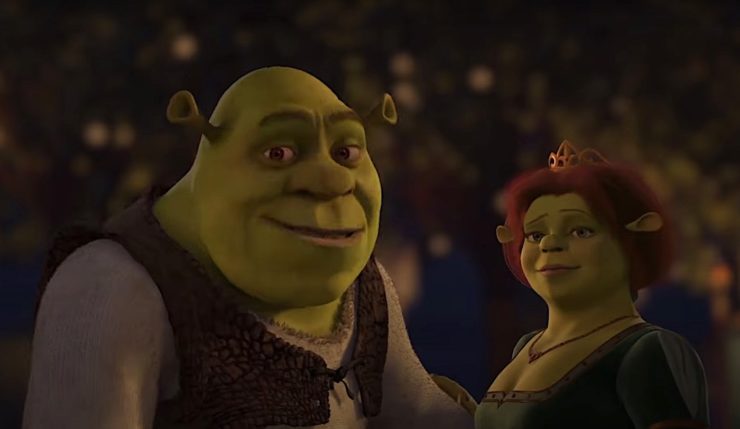Welcome to Close Reads! In this series, Leah Schnelbach and their guests dig into the tiny, weird moments of pop culture—from books to theme songs to viral internet hits—that have burrowed into our minds, found rent-stabilized apartments, started community gardens, and refused to be forced out by corporate interests. This time out, Samara Breger takes us for a stroll through a swamp to discuss the sensual power of animated ogres and subversive self-love.
The fourteenth-century poem the Grímnismál provides much of our modern understanding of the concept of Valhalla, the mythological resting place of heroes. According to this and other contemporaneous texts, the wise god Odin personally selects fallen warriors to populate this golden afterlife, sending Valkyries on winged horses to usher each of the slain to the glorious beyond. If this mythology is to be believed, then it is certain a Valkyrie was sent for Mongo, the giant gingerbread man, felled by steamed milk and a drawbridge as he battled palace guards in an effort to aid the hero Shrek in the film Shrek 2. There is no greater honor for this warrior, who lost his life in one of the best animated action sequences of all time.
The first Shrek movie is a strange dichotomy, as much a heartwarming story of love and redemption as a blatant F-you to the Disney top brass, gleefully delivered by Dreamworks co-founder and disgruntled former Disney exec Jeffrey Katzenberg. It isn’t subtle; the antagonist, the diminutive megalomaniac Lord Farquaad (say it out loud) is almost certainly a thinly-veiled parody of Disney CEO Michael Eisner. The film takes frequent pot shots at Katzenberg’s former employer, slyly reconfiguring Disney favorites such as Pinocchio and the magic mirror, and dropping them into a clunky, CGI world alongside the farting, foul-mouthed, surly ogre, Shrek (Mike Myers) and his wise-cracking Donkey sidekick (Eddie Murphy).
Outside of the cheekiness, it is the film’s central story that truly sets it apart from its Disney counterparts. At the end of the first movie, after a climactic, magical kiss, Princess Fiona (Cameron Diaz) does not become the slender, princess-shaped version of herself, rather a large, green ogre. “But I don’t understand,” she says. “I’m supposed to be beautiful.” “But you are beautiful,” Shrek replies.
Disney could never.
It is this earnest storytelling, cleverly paired with visual jokes, pop music, and sly winks, that is key to the Shrek properties’ winning formula, and there is no better example of this than the climactic rescue scene from the sequel film. For the uninitiated, here’s where we are: After Shrek and Fiona’s marriage, the nefarious Fairy Godmother (Jennifer Saunders) concocts a plan to claim a once-again-human Fiona for her own son, Prince Charming (Rupert Everett). To save Fiona from a love potion aimed at Charming, Shrek and Donkey (magically transformed into a human and a horse, respectively) must enter Fiona’s parents’ castle before the stroke of midnight. For help, they have brought along swordsman Puss in Boots (Antonio Banderas), the Gingerbread Man (Conrad Vernon), and Mongo (Conrad Vernon), a giant cookie baked by The Muffin Man (Conrad Vernon) who, naturally, lives on Drury Lane.
To set the mood for love and magic, the Fairy Godmother, clad in a sparkling red dress, launches into Bonnie Tyler’s “Holding Out For A Hero.” She lays luxuriantly on the piano and sings into her wand-turned-microphone, revealing a church choir and a full band, hidden on a rising stage.
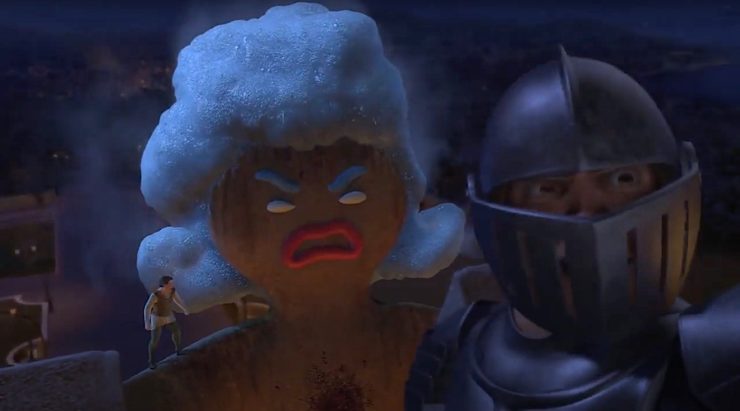
This is the first of many visual gags in the tightly-choreographed sequence. To hold off Mongo at the gates, the palace guards steam milk to pour on him; he rises with a hairdo made of foam. The palace guards shoot a fireball at Mongo, turning one of his gumdrop buttons into a flaming projectile; he hurls it back. He shrieks like Godzilla, wild and infuriated, a creature of vengeance and destruction. Eventually, he falls into the moat, delivering a gentle “Be good,” to a distraught Gingerbread Man. “He needs me! Let me go!” Gingy wails as Pinocchio carries him from the slowly sinking body.
We, the viewers, have earned this moment of high drama and showy heroism. We know the ogre of the first Shrek down to his jam-caked toes. We know his world and its stakes. And yet, we have never seen Shrek as we do in Shrek 2: nimble and beautiful and downright fuckable in his human form. We have never seen anything equal to the devastation of a cookie going down in glorious battlefield sacrifice. Now, the movie that gave us a farting, green fairytale hero, once again warps our expectations—behold, our Shrek. Here is the hero for whom we have been holding out. Here he is, zip lining on chains, swinging onto the back of his noble steed. Here is our man, striding onto the dance floor and demanding in a knee-tremblingly masculine baritone, “Hey you, back away from my wife.” He, along with his found family, smites the evil Fairy Godmother, turning her into a few, infinitely poppable bubbles. This is Shrek’s bravery, unleashed, earnest, and eager. One might say that the studio that queered the fairytale format has queered it again—queered it so hard, it’s nearly gone straight. It is almost easy to believe that this is who Shrek was always meant to be.
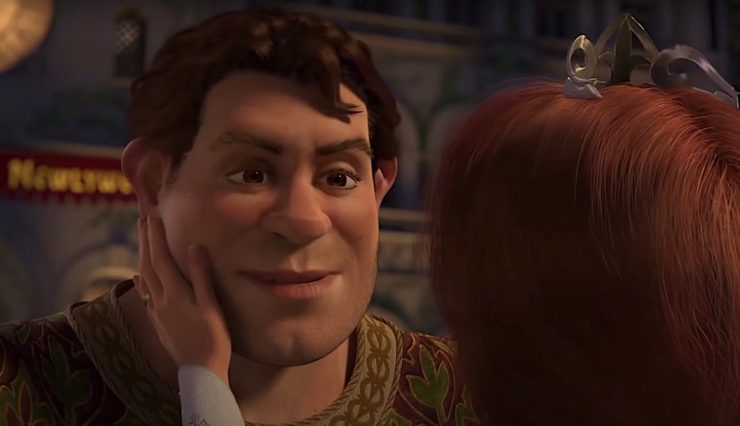
But of course, this is Shrek. He has, as the saying goes, had greatness thrust upon him. Through two movies, Shrek’s chief desire has been for a quiet life on his muddy swamp. But here he stands, ready for one more great sacrifice: Shrek is willing to kiss Fiona before midnight, thus making permanent the magic that turned them into beautiful humans. This ogre—for no matter his physical form, he bears the soul of an ogre—who reveled in the fetid nature of his species, is willing to change his life for his wife. This muddy beast is ready to go clean. Luckily for us, Princess Fiona loves Shrek as much as we do. “I want what any princess wants,” she says. “To live happily ever after… with the ogre I married.”
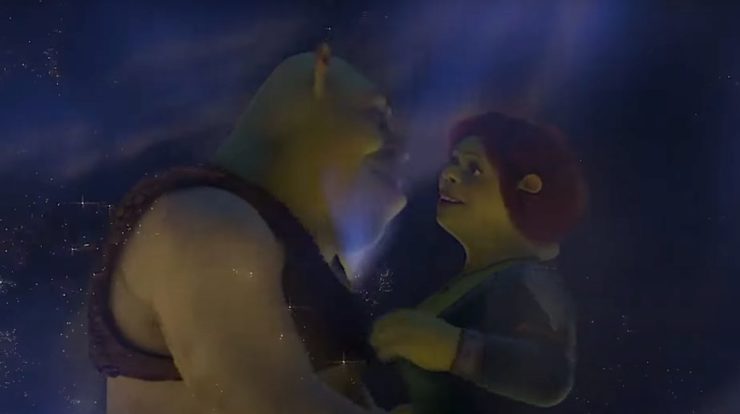
I only recently watched Disney’s 1997 adaptation of The Hunchback of Notre Dame and, while I was gratified to see an appropriately-hunchbacked hero, I was equally dismayed to learn that Quasimodo does not end up with the beautiful Esmeralda. She opts for the Kevin Kline-voiced Phoebus, a straight-backed, conventionally attractive blonde. It is not Disney’s lack of imagination, rather fear of subversion that keeps the seemingly-unfuckable heartbreakingly-unfucked; during points in the development in the film, Quasimodo and Esmeralda had their own love story. But in the version that made it to theaters, Quasimodo settles for a child’s embrace, symbolizing the adoration and acceptance of the people of Paris. While this is lovely, the respect of all Parisians does little to warm an eager hunchback’s bed.
That Shrek and Fiona end up ugly and happy about it is the most subversive narrative choice in the Shrek franchise. It puts me in mind of the end of Beauty and the Beast, wherein Belle is rewarded for her steadfastness with a handsome prince of her own, transformed by true love’s kiss. Shrek and Fiona are similarly transformed, but the reward is even greater—it is to be seen as they truly are. They love each other ugly, as Belle did her beast, but the love is its own reward. The ugliness is the beauty. This is Katzenberg’s greatest F-you, his office-clearing crop-dust as security escorts him off the Disney campus. He gave us a Disney-quality turn of heroism, and then produced something even greater. Now I’m a believer.
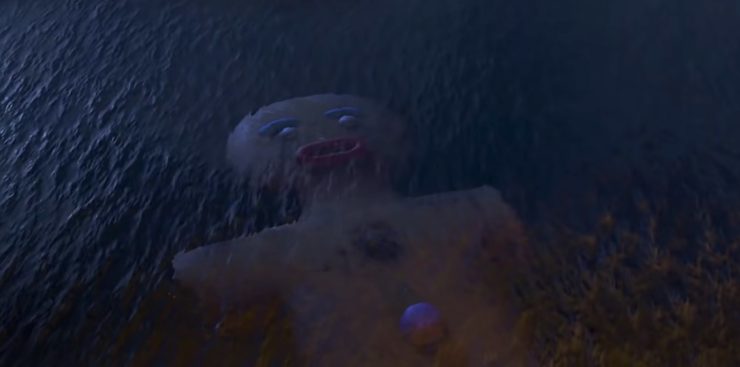
The first Shrek ended with a musical number, and this one is no different. Donkey and Puss perform Ricky Martin’s “Livin’ La Vida Loca”, accompanied by all of the characters in attendance. During the chorus, we see Mongo, underwater, singing along. I like to think that, as he blinked his frosting eyes at a sky of infinite stars, he saw an armored woman on a winged horse, her arm outstretched, ready to carry him home.
Buy the Book
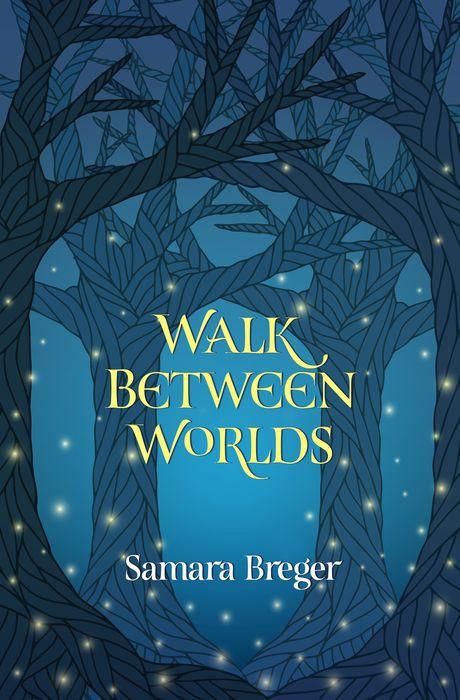

Walk Between Worlds
Samara Breger’s own queer fairytale, Walk Between Worlds, is available at your favorite bookstore. When she isn’t writing, she likes to read about gay people falling in love.










